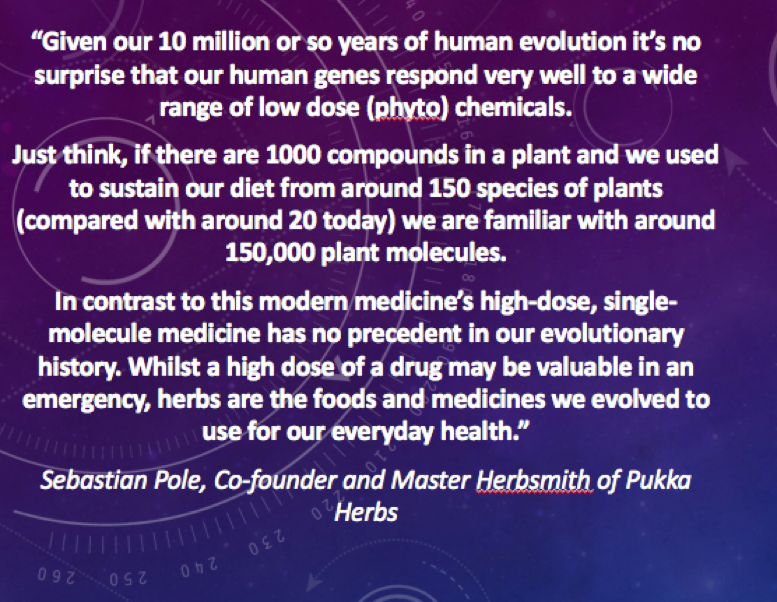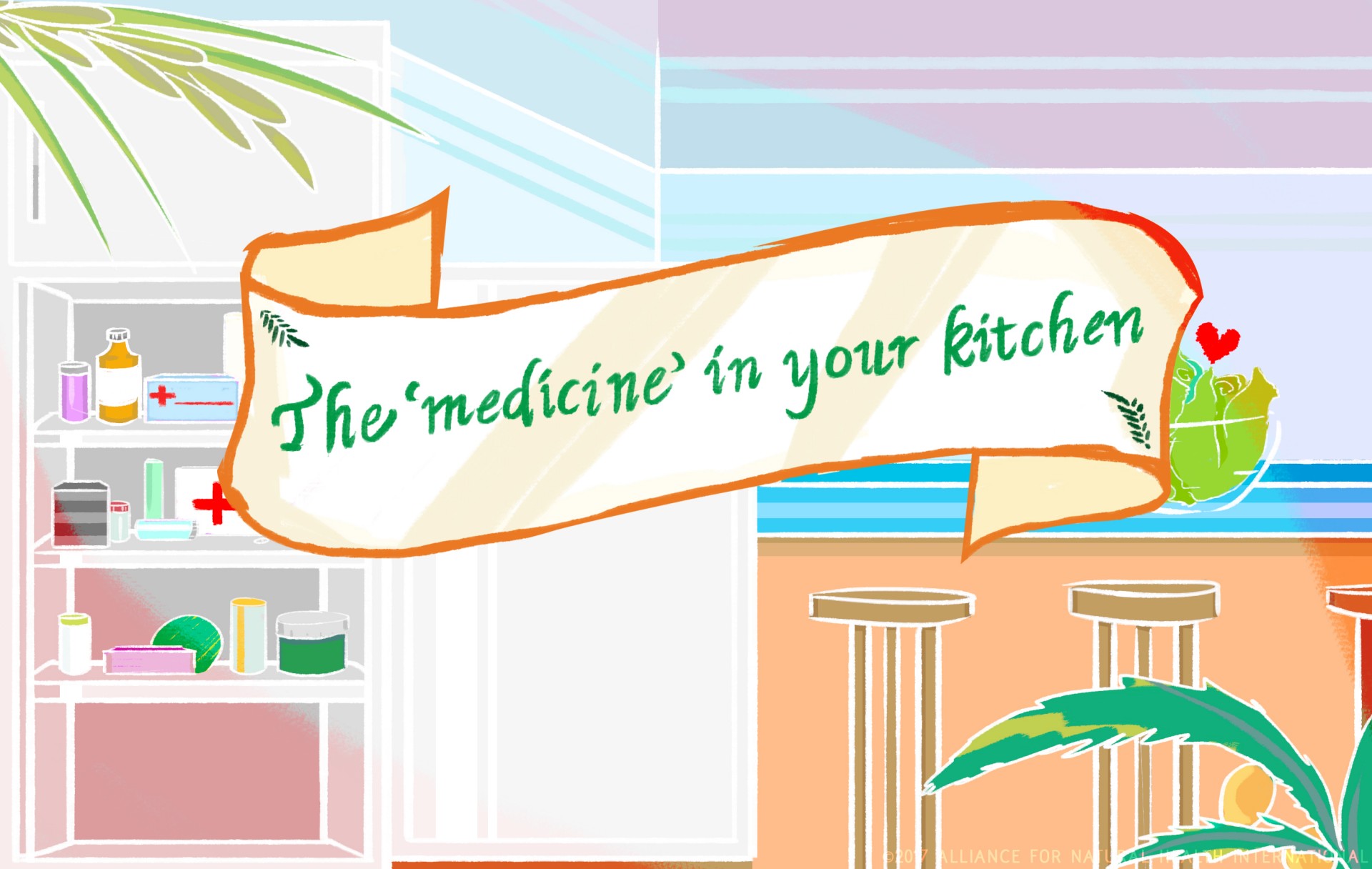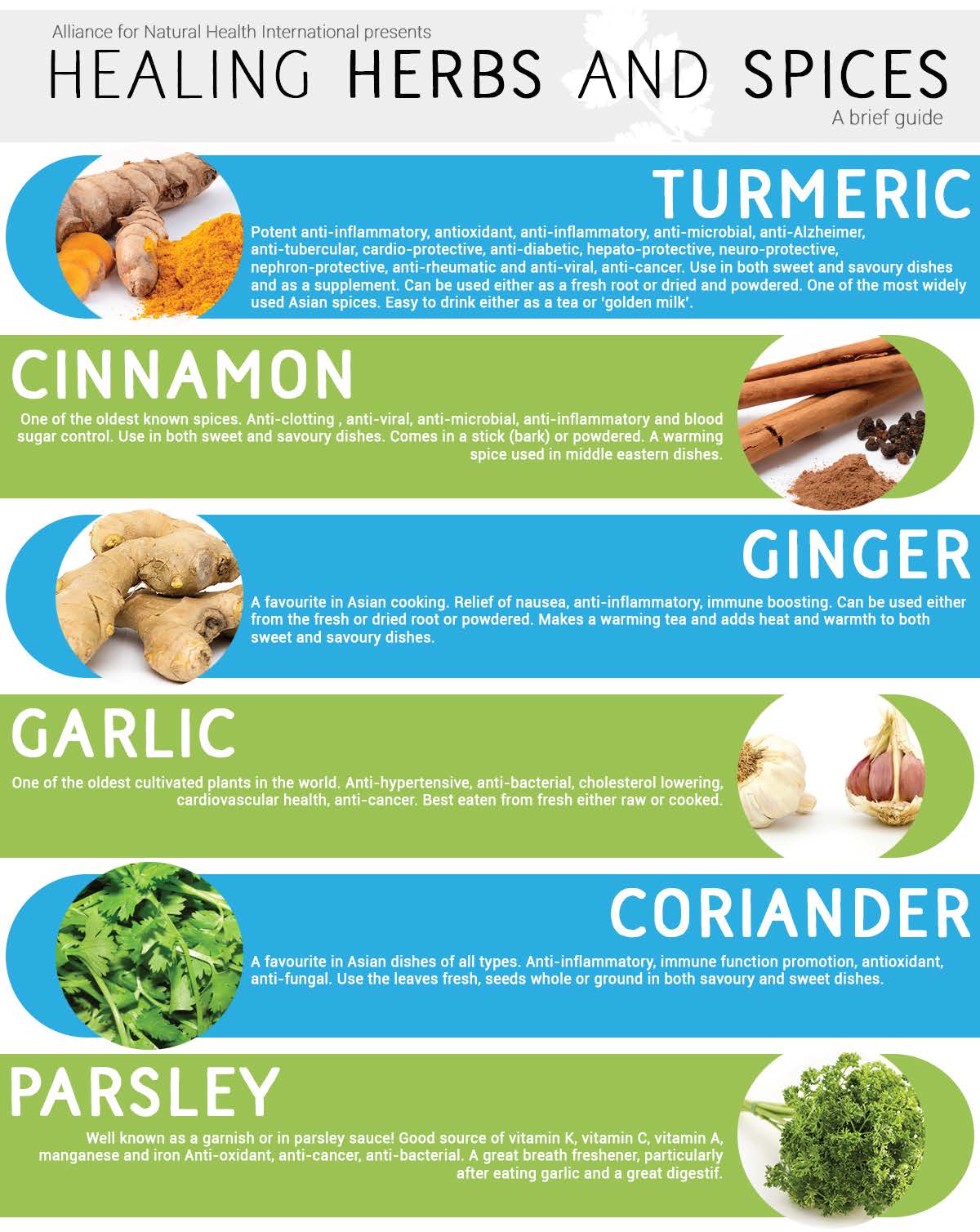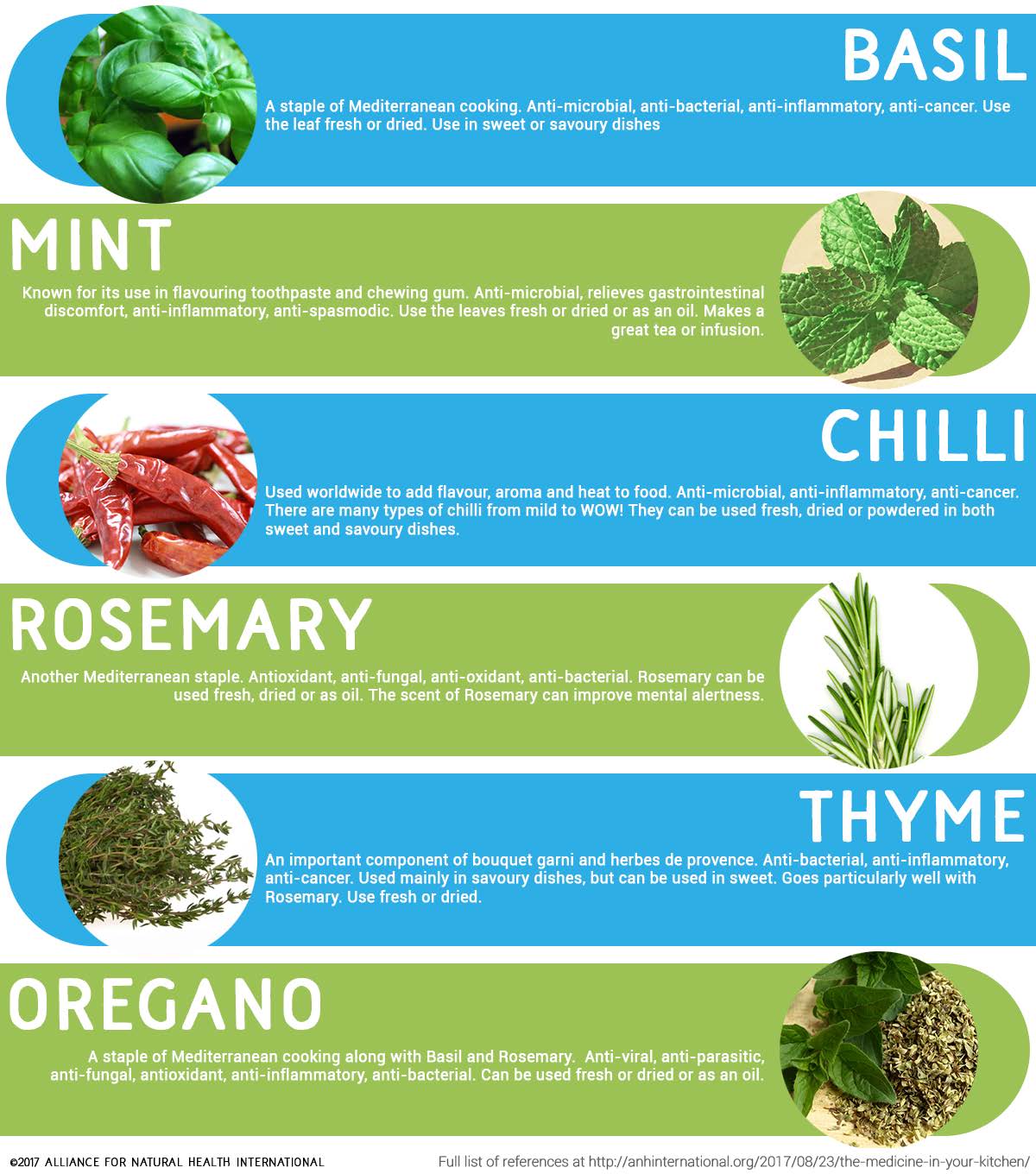Content Sections
“A herb is the friend of physicians and the praise of cooks.”
Charlemagne – 9th Century
A pinch of this and a sprinkle of that! Culinary herbs used to be a mainstay of food preparation. Their use in the days before fridges was to sanitise and preserve food, assist digestion, provide medicinal benefits and prevent food poisoning. The same active compounds that were present 'back in the day' can still be found today, yet most people add herbs and spices to their food simply for flavouring purposes. Many culinary herbs found in supermarkets are also often degraded versions of their original cousins. Do you recognise, for example, that there’s an enormous difference between dried and fresh herbs and spices? Your kitchen is truly the heart of your medicine cabinet.
Humans have been using medicinal plants since time immemorial, but today - at least in mainstream medicine - their use is largely overlooked. With the overreliance on modern drugs (around 75% of which have distant origins from plant compounds), the use of plants as medicine (herbalism) has largely been relegated to the fringes of healthcare, labelled as 'alternative' or 'complementary' medicine. In the third of our articles on dietary diversity we explore why we should be including more fresh herbs and spices in our daily diet. That's why they are of sufficient importance, in our view, to warrant their own segment in our Food4Health guideline ‘plate’.
Herbs and spices don’t just add flavour to food or beverages, they are packed with phytonutrients, antioxidants, minerals and vitamins that are essential to achieve and maintain optimal health.
Read on before you consider how your kitchen spice rack stacks up!
Herbal history
Medicinal uses of plants have been described in writings as far back as 3,000 BC in both ancient Chinese and Egyptian texts. Indigenous cultures relied (and still rely) on medicinal plants as their first line medicine, as do traditional medicinal systems such as Ayurveda and Traditional Chinese Medicine today. This isn’t unique to humans, animals have been doing the same through evolution. In fact, the non-nutritive, medicinal consumption of a diverse range of plant foods has been long known in our nearest non-human primate relatives, chimpanzees, bonobos and gorillas.
So powerful are their active compounds that botanicals form the basis for many of today’s pharmaceutical drugs. Unfortunately, these new-to-nature molecules don’t work in the same way or respect the cells of the body in the same way as nature, which is why so many drugs have such serious adverse side effects. Despite ongoing attacks on natural health therapies, such as herbalism and nutritional therapy, drug companies continue to look towards plants for new compounds. Sadly, ethnopiracy/biopiracy is yet another area of cultural and environmental abuse perpetrated by Big Pharma intent on bumping up its pharmaceutical product pipeline.

The medicine at your fingertips
Click on the infographic to download as a pdf
For avoidance of doubt, the term 'herb' usually refers to the fresh or dried leaves of plants, that are usually green. A 'spice' typically refers to the flowers, fruit, seeds, bark and roots of plants. These are generalisations of course, and oftentimes spices used in teas are referred to as herbal, rather than spiced, teas.
We are at differing stages of understanding of herbs and spices scientifically. Given present knowledge, one spice has emerged as a cheerleader for the multi-faceted benefits of many herbs and spices, benefiting just about every cell in the body through its multi-target functions. It deserves a special mention. Its potency has been closely studied, leading to descriptions such as, “Ancient; tried and tested; multi-faceted; proven; the closest thing to a magic bullet; state-of-the-art…..”.
If you’ve not already guessed, we’re referring to turmeric (a member of the ginger family). One of the most well-studied active ingredients in turmeric is curcumin described in a 2016 paper as, “A natural antioxidant….anti-inflammatory, anti-microbial, anti-cancer, anti-Alzheimer…anti-tubercular, cardio-protective, anti-diabetic, hepato-protective, neuro-protective, nephron-protective, anti-rheumatic and anti-viral”. There are now over 7000 published research studies that have shed light on the antioxidant, hypoglycaemic, anti-inflammatory and anti-cancer activities of turmeric’s most studied active principle, curcumin. And the best thing, when you use the whole spice, turmeric, especially in its fresh form, you get an array of additional benefits, including greater therapeutic benefits and improved absorption into the body courtesy of its essential oils. Better still, you don't need to go to a pharmacy; in an increasing number of good quality food or health stores, you can find fresh turmeric root that you can prepare yourself in a wide range of dishes, smoothies or herbal infusions (teas) in your own kitchen!
Turmeric root looks like a gnarled baby finger. It’s bright orange inside, which is why it’s often referred to as the “golden spice”. It’s become one of the hottest properties in natural medicine. Pharma companies are also in on the act, often ignoring the complexity of the natural product. In fact, Big Pharma is salivating over how it can tweak some of turmeric’s active principles to create synthetic analogues that can then be patented with a view to maximising profits.
Spice up your life!
Herbs and spices are readily available in health stores, groceries and supermarkets. The seeds and young herbs are also widely available in garden centres. Why not try growing your own on window sills, patios, veg plots or in amongst your garden borders? Fresh herbs and spices freeze well and are then always on hand to add to food, drink as herbal teas, make oil infusions or dehydrate and sprinkle on food.
As with all foods, the better the quality and the optimal dosage for an individual, the more therapeutic the benefit. Be aware that most, non-organically certified dried herbs and spices have been irradiated for longer-shelf life and to destroy microorganisms and insects. This may damage the health-giving compounds, rendering them little more than flavour enhancers. Many of the active compounds are delicate and are damaged by excessive processing, heat and light so treat your herbs and spices with respect and freeze them to keep them fresh.
Herbal teas – beverage delivery system for herbal constituents
Herbal teas are widely seen by the public as an alternative to caffeinated beverages like tea and coffee. Many herbal teas, regardless of their quality, also appeal because they taste pleasant or interesting; they make a nice tasting beverage too. But, in reality, a good quality herbal tea is so much more than this. A quality herbal tea provides an amazing way of delivering water-soluble components from herbs to the body. It’s a system that’s been developed over thousands of years in a range of traditions, some of the most comprehensive coming out of the Indian (Ayurvedic) and Chinese medicine traditions.
Sadly, there are companies out there that exploit the public interest in herbal teas, without delivering the authentic article, namely a beneficial or therapeutic tea. These lower quality commercial herbal teas typically include flavourings, often unspecified synthetic ones, and very small amounts of therapeutic herbs or poor quality, non-pharmacopoeial grade herb sources. Lower quality teas may be contaminated with microorganism toxins e.g. aflatoxin, pesticides, heavy metals or other contaminants, such as polyaromatic hydrocarbons, pyrrolizidine alkaloids. They might also be sold in chlorine-bleached or plastic/silken bags made from GM corn.
The hot water that is applied to the tea is crucial to the quality of the final beverage. Most good quality herbal teas need to be infused for at least 4 minutes to ensure that the phytochemicals in the herbal materials are extracted in sufficient amounts to be beneficial or therapeutic. It often helps to agitate or stir the tea during the infusion process.
Here’s some of our key advice on herbal teas:
- Select teas comprised of organic sources of herbs to avoid/minimise exposure to contaminants
- If the tea is delivered as a tea bag, ensure the bag is not made from bleached (chlorine-containing) paper or polylactic acid (‘silk’ types) the vast majority of which are made from genetically-modified maize/corn
- Avoid any herbal tea that includes flavours, whether these are natural or synthetic
- Infuse in hot water for at least 4 minutes, agitate tea bag or stir herbal ingredients with a spoon to ensure adequate extraction of phytochemicals
- Check for any precautions on the label, as some herbal teas are powerfully therapeutic and over-consumption may give rise to specific risks in sensitive individuals
If you’re interested in making your own herbal infusions, you may like to refer to the new book by Sebastian Pole, co-founder of Pukka Herbs, entitled ‘Cleanse, Nurture, Restore with Herbal Tea’.
Recipes
Here are two easy and quick recipes that add a punch of flavour and huge hit of phyotnutrients to meals:
CHIMICHURRI (a traditional South American sauce often used with grilled meat but that can be added to veg as well!)
Ingredients
1/2 cup coarsely chopped fresh, flat-leaf parsley
1/4 tablespoons oregano (cilantro) (ideally fresh, including washed, chopped roots)
3 tablespoons red/white wine or apple cider vinegar
4 large garlic cloves, minced (2 1/2 tablespoons)
2 teaspoons freshly crushed red bell pepper
Salt and freshly ground black pepper
1/2 cup extra-virgin olive oil
Method
- Finely chop the parsley and oregano
- Add the vinegar, garlic and crushed red pepper
- Season with salt and pepper
- Transfer the sauce to a bowl and pour the olive oil over the mixture, mix well
- Let it stand for at least 20 minutes
Can be made ahead and refrigerated overnight. Bring to room temperature before serving. Can also be used as a marinade.
Variations: This sauce is a great way to get more powerful herbs and spices into your diet. Mix it up with additions/substitutions such as paprika, cumin, thyme, lemon, basil, coriander (cilantro), basil or sage. In its red version, tomato may also be added and for those of you who like a little more spice, add some chopped chilli peppers.
PESTO (a traditional Mediterranean sauce)
Ingredients
1 large bunch basil leaves
3 medium cloves of garlic
1 small handful raw pine nuts
¾ cup Parmesan, grated
A few tablespoons of extra virgin olive oil
If you have a food processor, throw in all the ingredients and blend. It’s just as easy to make by hand.
- Mince or crush the garlic
- Chop the basil
- Chop the pine nuts
- Mix the garlic, basil and pine nuts together with the parmesan
- Add the oil and mix well
Variations: If you’re dairy free omit the cheese or use a dairy-free alternative. Mix it up with basil, coriander (cilantro), rocket (arugula) or watercress and replace the pine nuts with walnuts or almonds. Really the variations are endless, so just experiment!
The beauty of both recipes is that they can be varied according to the herbs you have available, or prefer, and they both freeze well.










Comments
your voice counts
24 August 2017 at 11:59 am
Thank you for covering this important subject. However I suggest that it is a mistake to distinguish between the flavour and physiological benefits of herbs and spices. We tend to like a taste in part because of the benefit that the food produces and we can even say the benefit is in at least in part in the taste.
I am also doubtful of the validity of the implication you seem to make that fresh herbs and spices are always better than the dried forms. More or less different but not necessarily less valuable.
All the best
16 May 2018 at 10:45 pm
I'm thrilled to see the recognition given to herbs and spices as part of a healthful diet. Thank you so much!
Your voice counts
We welcome your comments and are very interested in your point of view, but we ask that you keep them relevant to the article, that they be civil and without commercial links. All comments are moderated prior to being published. We reserve the right to edit or not publish comments that we consider abusive or offensive.
There is extra content here from a third party provider. You will be unable to see this content unless you agree to allow Content Cookies. Cookie Preferences